G
NIKI DE SAINT PHALLE & JEAN TINGUELY: MYTHS & MACHINES
HAUSER & WIRTH SOMERSET
NIKI DE SAINT PHALLE
& JEAN TINGUELY: MYTHS & MACHINES
HAUSER & WIRTH
SOMERSET
May 17, 2025
– February 1, 2026
‘We couldn’t sit down
together without creating something new, conjuring up dreams.’—Niki de Saint
Phalle, ‘A little of my story with you Jean’ (1996)
Niki de Saint Phalle
(1930 – 2002) and Jean Tinguely (1925 – 1991) are reunited in a major site-wide
takeover at Hauser & Wirth Somerset in collaboration with the Niki
Charitable Art Foundation. The first exhibition dedicated to both artists in
the UK will illustrate Saint Phalle and Tinguely’s visionary artistic output
and enduring creative collaboration over three decades. Two emblematic figures
of contemporary art, Saint Phalle and Tinguely defied conventional artmaking
and were fuelled with rebellion, in both life and art. The exhibition will
feature unseen works on paper and art décor by Saint Phalle, alongside her
Shooting Paintings and monumental open-air sculptures. Iconic kinetic machines
by Tinguely range from the 1950s to the final year of his life, in addition to
multifaceted collaborative works made by the duo throughout the 1980s.
The Bourgeois Gallery
introduces the artists’ distinct visual language, production methods and social
commentary that developed in parallel, and through collaboration, over the
course of their careers. The Tinguely works within this space are exemplary of
his sculptural practice as research, exploring art based on movement, chance,
relative speed and sound. His ‘anti-machines’ feel more relevant now than ever
before, constructed from scrap metal and an assemblage of found materials,
designed to highlight the flaws of modern technology and society’s displacement
of humanity. Overlooking these works stands Saint Phalle’s ‘Big Lady (black)’
(1968/1995). By 1965, Saint Phalle began to introduce polyester to create more
voluptuous dancing figures that could be displayed in public parks and other
outdoor locations, as seen in ‘Les Trois Graces’ (1995 – 2003) that is
presented in the farmyard in Somerset.
The Rhoades Gallery
features Saint Phalle’s first functional sculptures, made for the film ‘Un Reve
plus long que la nuit’ (1976). The film was written, directed and acted by
Saint Phalle, alongside Tinguely and her daughter Laura Duke. Art and life were
interchangeable in Saint Phalle’s universe and the decorative elements for the
film, such as thrones, tables and mirrors, instigated a sustained interest in
making art to be lived with, which resulted in larger-scale immersive projects.
It was Saint Phalle’s passion for fantasy and mythology that contributed to
Tinguely’s monumental sculptural work, ‘Le Cyclop’ (1969 – 1994), in the forest
of Milly-la-Forêt, France, a project of boundless action between artists and a
dream of utopia. A mutual source of inspiration can be seen in ‘Le Grande Tête’
(1988), a union of Tinguely’s robust mechanical base with Saint Phalle’s
mysterious abstract face as a silent observer, a motif she began developing
from the 1970s, in response to multiple realities and dream states that can
exist simultaneously. Skating amongst the gold furniture is ‘Patineuse’ (c.
1967), from her most famous and recognizable series, the Nanas. Saint Phalle’s
army of brightly colored Nanas interrogate the various roles of women, often
liberated from tradition and radiating energy and vitality.
The Pigsty Gallery pays
homage to Saint Phalle’s Shooting Paintings, which began in 1961 against a
backdrop of political violence and unrest in France. Saint Phalle fired a rifle
at canvases or low reliefs resembling alters or effigies, often exploding bags
of hidden paint across the work’s surface. The process of creation was a
paradoxical destructive act, utilizing sensations of violence and demolition to
promote a sense of renewal and catharsis for the artist and the viewer. The
performative action was both inward-looking, demonstrating Saint Phalle’s
regaining of control and strength over a strict Catholic upbringing and abusive
father but, at the same time, responding to the period in which they were made,
and bursting with rage at institutional forces and masculinist values. Tinguely
was a primary supporter of these works and his own auto-exploding sculptures
and incendiarism in art shared this adventurous spirit and eagerness to
challenge artistic norms.
The Workshop Gallery
presents an intimate collection of drawings and works on paper by Saint Phalle,
many of which reflect on her relationship with Tinguely and the creative
stability and trust they provided for one another. The repetition of birds,
snakes, dragons and mythical creatures appear frequently in Saint Phalle’s
writings and sculptural work, drawing from the symbolic language of African,
pre Columbian and eastern cultures. Birds are often believed to be messengers
from one world to the next, representing complete freedom and immortal
reinvention. In addition to independent works by Tinguely, including ‘Radio
Sculpture’ (1961), ‘IBM’ (1960) and Rocker III (1963), stands a final
collaborative work, ‘Pallas Athéna (le chariot)’ (1989) that relates to the
seventh card in the Tarot which appears in Saint Phalle’s Tarot Garden in
Garavicchio, Italy.
Saint Phalle’s extraordinary combination of architecture, the enchantment of nature, and the spiritual world is integral throughout her practice, most notably in her ambitious vision for the Tarot Garden. This is prominent across the open-air presentation in Somerset, including ‘The Prophet’ (1990), ‘Tête de mort I’ (1988), ‘Le Poète et sa Muse (1999) and ‘Les Trois Graces’ (1995-2003), alongside Tinguely’s ‘Fountain III’ (1963), a large motor-driven fountain on display in the Rhoades Gallery lobby that will be activated throughout the summer.
Hauser & Wirth Somerset’s Education Lab will take its starting point from Niki de Saint Phalle’s early experiences of personal trauma and embody her philosophy that creativity can serve as both a mental antidote and a therapeutic outlet. In partnership with the East Somerset Federation, consisting of Bruton Primary School, Ditcheat Primary School and Upton Noble C of E Primary School, the Education Lab will provide an interactive space realized by young people as an exploration of their emotions, experiences and stories.
NIKI DE SAINT
PHALLE
Le Poète et
sa Muse, 1999
Polyurethane
Foam, Fiberglass Resin, Steel Armature, Stained and
Mirrored
Glass, Glass Pebbles on Metal Base Plate
Dimensions:
436.9 x 193 x 152.4 cm
© Niki Charitable Art Foundation. All Rights Reserved, DACS 2025
NIKI DE SAINT PHALLE
Le Poète et sa Muse, 1999 (Detail)
JEAN TINGUELY
Metamatic No.
20, 1959/1960
Iron Tripod and Bars, Bicycle Wheels,
Rubber Belts, Two Cooking Pans
Dimensions:
224 x 161 x 110 cm
© Jean Tinguely, DACS 2025
JEAN TINGUELY
Metamatic No. 20, 1959/1960 (Detail)
NIKI DE SAINT
PHALLE
Big Lady
(Black), 1968/1995
Painted
Polyester, Metal Base
EE; Ed. 1/1 +
EE
Dimensions:
247 x 157 x 80 cm
© Niki Charitable Art Foundation. All Rights Reserved, DACS 2025
NIKI DE SAINT PHALLE
Big Lady (Black), 1968/1995 (Detail)
JEAN TINGUELY
Chandelier,
1989 – 1990
Metal,
Plastic Components, Antlers, Colored Light Bulbs
Dimensions:
254 x 172.7 x 152.4 cm
© Jean Tinguely, DACS 2025
JEAN TINGUELY
Chandelier, 1989 – 1990 (Detail)
JEAN TINGUELY
CH (dit
Pierre Joseph Proudhon), 1988
Iron, Wooden
Wheel, Bumper With CH Adhesive, Vine Root,
Rubber
Tensioner, V-Belt, Electric Motor V220
Dimensions:
198 x 80 x 70 cm
© Jean Tinguely, DACS 2025
JEAN TINGUELY
CH (dit Pierre Joseph Proudhon), 1988 (Detail)
JEAN TINGUELY
Fontaine
(CNAC No. 1), 1962
Welded
Sculpture (Water Machine), Iron Wheels and Support,
Car Parts,
Fan, Rubber Belts and Hoses, Electric Motor V220
Dimensions:
132.7 x 80.2 x 112.7 cm
© Jean Tinguely, DACS 2025
NIKI DE SAINT
PHALLE
Les Trois
Graces, 1995 – 2003
Polyester,
Mirror Mosaic
Dimensions: Silver
Sculpture: 289.6 x 124.5 x 94 cm /
Black Sculpture: 259.1 x 152.4 x 88.9 cm /
White Sculpture: 289.6 x 119.4 x 88.9 cm
© Niki Charitable Art Foundation. All Rights Reserved, DACS 2025
JEAN TINGUELY
Halleluja,
1984
Welded
Sculpture, Iron Chains and Metal
Wheels on
Tree Trunk, 220V Electric Motor
Dimensions:
110 x 120 x 120 cm
© Jean Tinguely, DACS 2025
JEAN TINGUELY
Halleluja, 1984 (Detail)
ABOUT NIKI DE SAINT
PHALLE & JEAN TINGUELY
Niki de Saint Phalle
(1930 – 2002) and Jean Tinguely (1925 – 1991) were pioneering artists whose collaborative
works significantly influenced 20th Century art. Their partnership, both
personal and professional, began in the mid-1950s and spanned several decades.
Tinguely and Saint Phalle met and started working together in Paris, France,
eventually marrying in 1971. The pair forged an extraordinary personal and
artistic relationship that resulted in numerous groundbreaking projects that
combined their unique artistic visions.
Niki de Saint Phalle was
born in Neuilly-sur-Seine, France, but spent her childhood in the United
States. She was educated at a convent school in New York NY but spent her
summers in France. After a tumultuous childhood and a brief career in
modelling, she turned to art as a form of self expression and healing. Saint
Phalle was largely self-taught, drawing inspiration from diverse sources,
including Antoni Gaudí’s architectural works and indigenous art forms. Her
early works included the ‘Tirs’ series (1961 – 1964), in which she created
paintings by shooting at canvases embedded with bags of paint, a radical
approach that challenged traditional artistic methods. Saint Phalle gained
widespread recognition for her ‘Nanas’—large-scale, brightly colored sculptures
of female figures that celebrate femininity and fertility. Her most ambitious
projects was the ‘Tarot Garden’ (1979 – 2002) in Tuscany, Italy—a sculpture
park featuring monumental figures inspired by tarot cards. This endeavour
showcased her commitment to creating immersive environments that engaged
viewers on multiple levels.
Jean Tinguely was born in Fribourg, Switzerland, and grew up in Basel. He studied at the School of Arts and Crafts in Basel before moving to Paris, France, in the early 1950s. Tinguely became known for his kinetic sculptures, termed ‘Métamatics,’ which were mechanical constructions that incorporated movement and self-destruction, satirizing automation and the technological overproduction of material goods. Tinguely gained international attention with ‘Homage to New York,’ (1960) a self-destructing sculpture performed in the garden of the Museum of Modern Art (MOMA) in New York NY. This piece epitomized his interest in the ephemeral nature of art and the fusion of creation and destruction. His works often featured salvaged materials and whimsical designs, engaging audiences in novel ways.
Notable collaborative projects between Saint Phalle and Tinguely include: ‘Hon – en katedral’ (1966), a monumental installation at Moderna Museet in Stockholm, Sweden, featuring a giant reclining female figure that visitors could enter; the ‘Stravinsky Fountain’ (1983) near Centre Pompidou, in Paris, France, comprising 16 colourful sculptures inspired by Igor Stravinsky’s compositions; and ‘Le Cyclop’ (1969 – 1994), a monumental sculptural work in the forest of Milly-la-Forêt, France. Their collaborative efforts left an indelible mark on contemporary art, inviting audiences to engage with art in interactive and thought-provoking ways.
NIKI DE SAINT
PHALLE & JEAN TINGUELY
Nana Machine,
1976
Painted
Polyester, Iron Stand With Electric Motor by Jean Tinguely
Dimensions:
43.5 x 15 x 21 cm
© Niki Charitable Art Foundation. All Rights Reserved, DACS 2025
NIKI DE SAINT PHALLE & JEAN TINGUELY
La Grande Tête, 1988
Iron, Wood, Electric Motor, Bungee, Lightbulbs,
Polyester Head by Niki de Saint Phalle
Dimensions: 225 x 225 x 140 cm
© Niki Charitable Art Foundation. All Rights Reserved, DACS 2025
NIKI DE SAINT PHALLE & JEAN TINGUELY
Pallas Athéna (Le Chariot), 1989 (Detail)
NIKI DE SAINT PHALLE & JEAN TINGUELY
Pallas Athéna (Le Chariot), 1989
Iron, Steel,
Electric Motor and a Statuette of Painted Polyester With Gold Leaf
Dimensions:
80 x 220 x 120 cm
© Niki Charitable Art Foundation. All Rights Reserved, DACS 2025
HOW DID THE ARTISTS MAKE THEIR WORK?
Niki de Saint Phalle and Jean Tinguely’s collaborative making process was characterized by a dynamic interplay of materials, techniques and shared visions. Saint Phalle and Tinguely’s collaboration began with Saint Phalle’s request for Tinguely to construct an iron armature for her first sculpture in 1958. This initial collaboration evolved into a ‘four hands’ approach, where they alternated roles in the creative process. Saint Phalle would prepare, glue and paint, while Tinguely added elements like bent wires, resulting in unique assemblages that blended their individual styles.
JEAN TINGUELY
IBM, 1960
Iron Plate on
4 Screws, Computer Chip, Electric Motor
Dimensions:
26 x 26 x 12.5 cm
© Jean Tinguely, DACS 2025
JEAN TINGUELY
IBM, 1960 (Detail)
JEAN TINGUELY
Untitled from
Radio-Skulptur (Radio-Sculpture) Series, 1962
Iron Base,
Wheel With Tire, Radio, Wood Board, Electric Motor
Dimensions:
60 x 40 x 30 cm
© Jean Tinguely, DACS 2025
JEAN TINGUELY
Rocker III,
1963
Iron and
Electrical Components
Dimensions:
45 x 48 x 34 cm
© Jean Tinguely, DACS 2025
NIKI DE SAINT
PHALLE
Tête de Mort
I, 1988
Polyester,
Mirror, Palladium Leaf
Unique Series
of 6 (‘But’ all Different). Ed. 4/6
Dimensions:
114.3 x 127 x 86.4 cm
© Niki Charitable Art Foundation. All Rights Reserved, DACS 2025
NIKI DE SAINT
PHALLE
Patineuse,
1967
Painted
Polyester, Metal Base
Dimensions:
200 x 160 x 115 cm
© 2025 Niki Charitable Art Foundation. All rights reserved
WHAT DOES THE EXHIBITION
LOOK LIKE?
In the exhibition, ‘Myths
& Machines,’ Saint Phalle’s and Tinguely’s works take over Hauser &
Wirth Somerset, marking the first time both artists work has been shown
together in the UK.
Beginning in the
Farmyard, ‘Le Poète et sa Muse’ (1999) and ‘Les Trois Graces’ (1995 – 2003) are
displayed as visitors’ first encounter with Saint Phalle’s iconic ‘Nana’
figures. These sculptures, depicting voluptuous, joyful women in dancing poses,
are symbols of femininity and empowerment. Each figure is covered in mirrored
glass, a mosaic technique often used by Saint Phalle to harness the physically
and personally reflective power of the mirror.
In the Bourgeois Gallery,
Tinguely’s iconic kinetic machines occupy the space, ranging from the 1950s to
the final years of his life. These assemblage creations such as ‘Deng Xiaoping’
(1989) and ‘Laika’ (1989) showcase his innovative fusion of movement and sound
through assemblages of metal, electric motors, and found objects such as
wheels, chains and animal skulls. Overlooking these works stands Saint Phalle’s
‘Big Lady (black)’ (1968/1995). By 1965, Saint Phalle began to introduce
polyester to create more voluptuous dancing figures that could be displayed in
public parks and other outdoor locations, as seen in ‘Les Trois Graces’ (1995 –
2003) that is presented in the farmyard in Somerset.
On view in the Rhoades
Gallery, ‘La Grande Tête’ (1988) is a key example of Tinguely’s and Saint
Phalle’s creative collaboration, originally an element from ‘La Fontaine de
Château-Chinon’ (1988), given to Château-Chinon by former French President,
François Mitterrand, which features Saint Phalle’s vibrant sculptures alongside
Tinguely’s kinetic elements.
Saint Phalle’s golden
furniture is showcased for the first time in the Rhoades Gallery, reflecting
her view that art and design are joined, not separate. This collection,
comprising thrones, tables, and mirrors crafted from metal, polyester, and gold
paint, was originally created as decorative elements for her recently restored
film ‘Un Rêve Plus Long Que La Nuit’ (1975). Saint Phalle both wrote and directed
this film, featuring performances by herself and Tinguely.Her furniture pieces,
Nanas series and ‘Patineuse’ (1966 – 1967) exude a fantastical and
fairytale-like quality, aligning with the film’s dreamlike narrative.
Examples of how Saint
Phalle pushed the boundaries of traditional artistic techniques are on view in
the Pigsty Gallery with her ‘Petit Autels’ (small altars) (1970 – 1972), made
in connection with her ‘Tirs’ (shooting paintings) which began in 1961. These
works involved embedding paint-filled containers within plaster-covered
structures, which Saint Phalle would then ceremoniously shoot with a rifle,
causing the paint to burst in a vivid, performative act. The act of shooting
these altars can be seen as a symbolic destruction of unjust and oppressive
constructs, such as the strictness of the Catholic Church Saint Phalle’s
parents raised her in, allowing for the creation of new, liberated forms. This
reflects Saint Phalle’s engagement with feminist themes, confronting societal
perceptions of femininity and empowerment.
Key examples of
Tinguely’s and Saint Phalle’s collaborations are on display in the Workshop
Gallery with ‘Nana Dasant (Nana Mobile)’ (1976), the only edition they made
together, and ‘Pallas Athéna (Le Chariot)’ (1989). This work relates to the
seventh card in the Tarot which appears in Saint Phalle’s Tarot Garden in
Garavicchio, Italy. These works bring together Tinguely’s kinetic structures of
metal and motors and Saint Phalle’s sensual feminine sculptures, whilst still
bearing the signature of both artists. A collection of Saint Phalle’s 30 works
on paper, never exhibited before, are also shown, reflecting her exploration of
personal themes and societal commentary through form, color and composition.
Monumental open-air
sculpture, ‘The Prophet’ (1990) is on view in the Oudolf Field amongst the
garden’s landscaping. The piece is part of a series created by Saint Phalle
whilst in the Tarot Garden in Tuscany, Italy. Tinguely’s dynamic fountains are
exhibited, underscoring both artists’ efforts to blend art, movement and the
natural world into immersive experiences.
NIKI DE SAINT
PHALLE
[Goddess
Creature], 1992
Watercolor,
Pencil on Photo Copy
Dimensions:
30.7 x 22.8 cm
© Niki Charitable Art Foundation. All Rights Reserved, DACS 2025
NIKI DE SAINT
PHALLE
[Everything
is in Mouvement...], 1997
Felt Pen, Ink
Stamp, Sticker Collage, Watercolor, Pencil on Litho Paper
Dimensions:
27 x 23 cm
© Niki Charitable Art Foundation. All Rights Reserved, DACS 2025
NIKI DE SAINT
PHALLE
[Design With
Face], Undated
Colored Ink
on Paper
Dimensions:
50.2 x 65.4 cm
© Niki Charitable Art Foundation. All Rights Reserved, DACS 2025
NIKI DE SAINT
PHALLE
Lit (Élément
du Décor du Film ‘Un Rêve Plus Long Que La Nuit’), 1974
Polyester
Painted With Gold Paint, Metal Structure
Dimensions
Variable
© Niki Charitable Art Foundation. All Rights Reserved, DACS 2025
JEAN TINGUELY
Le Cercle
Infernal de la Mort, 1990
Root Stock,
Iron, 11 Roebuck Skulls, Electric Motor
Dimensions:
200 x 170 x 120 cm
© Jean Tinguely, DACS 2025
JEAN TINGUELY
Le Cercle Infernal de la Mort, 1990 (Detail)
NIKI DE SAINT
PHALLE
L’Autel des
Innocents, 1962
Various
Objects Embedded in Plaster, Plywood
Dimensions:
100 x 70 x 15 cm
© Niki Charitable Art Foundation. All Rights Reserved, DACS 2025
WHAT ARE THE MAJOR THEMES
WITHIN THE EXHIBITION?
REBELLION
Saint Phalle and Tinguely
viewed creation as an act of defiance against established norms. Their works
often convey aggressive undertones, challenging societal conventions through
bold and provocative expressions. Saint Phalle’s practice is testament to
artistic rebellion, intertwining aggressive subtexts with feminist ideals. Her
‘shooting paintings’ invited viewers to participate by shooting colour-filled
packets with rifles, transforming traditional art into an action-oriented
experience. This participatory approach not only garnered significant attention
but also aligned with the principles of action painting, emphasising the
physicality of creation. Central to her work are the ‘Nanas’, vibrant
sculptures of female figures that challenge conventional representations of
women, positioning them as ‘female warriors’ in the art world. These large
scale creations also assert the capability of female artists to produce
monumental works, reinforcing their presence in a domain historically dominated
by men. Tinguely’s kinetic sculptures often incorporated elements of disorder,
inviting viewers to engage with the unpredictable nature of his machines. Tinguely
not only questioned the role of the artist and the permanence of art but also
invited audiences to engage with the transient and often chaotic essence of
creation. Collaboratively, Saint Phalle and Tinguely pushed artistic
boundaries, embodying a shared commitment to using art as a vehicle for social
commentary and transformation.
HEALING
Niki de Saint Phalle’s
journey of healing through art is deeply rooted in her tumultuous early life
and personal challenges. Born into an aristocratic family that faced financial
ruin during the Great Depression, she endured a strict upbringing and a
traumatic childhood. Following a severe nervous breakdown that led to
hospitalization, Saint Phalle began creating collages using pebbles, leaves and
found materials. Encouraged by a friend who provided her with gouaches and
brushes, she developed a unique style that combined painting and assemblage.
Her early works, such as the shooting paintings, served as cathartic
expressions of her inner turmoil. In her later years, Saint Phalle continued to
explore themes of healing and self-discovery through monumental projects like
The Tarot Garden in Tuscany, Italy, envisioned as a place of reflection and and
restoration, described by Saint Phalle as ‘a promenade between nature and
culture.’ This process of artistic exploration became a vital means for her to
confront and process her emotions, dreams, and traumas, ultimately serving as a
therapeutic outlet that facilitated her personal healing and growth. Her life
and work continue to inspire discussions on the intersection of art and mental
health.
MOVEMENT & MECHANICS
Tinguely’s exploration of
movement and mechanics transformed static sculptures into dynamic, kinetic
experiences. Tinguely mechanized sculptural assemblages composed of found
objects, primarily scrap metal, introducing movement into his art. He referred
to these creations as ‘Métamatics,’ emphasising their self-referential nature
and challenging conventional notions of art and functionality. Tinguely’s works
often incorporated motors and moving parts, inviting viewers to engage with art
that was not merely observed but experienced through motion. This integration
of movement and mechanics not only expanded the possibilities of sculptural
expression but also served as a satirical commentary on the overproduction and
mechanisation prevalent in modern society. By infusing his sculptures with
movement, Tinguely invited viewers to reconsider their perceptions of art,
technology and the mechanized world around them, bringing freedom and life to
machines. As Tinguely remarked, ‘le movement c’est la vie (movement is life)’.
MYTH & FANTASY
Saint Phalle’s and Tinguely’s creative practices were imbued with fantasy and myth. Saint Phalle often immersed herself within the very sculptures she crafted, transforming these spaces into imaginative worlds that were creatively liberating. In her early drawings, Saint Phalle wove together vibrant, interlocking scenes populated by recurring motifs—fantastic creatures, fairytale landscapes and real-life imagery like cars, planes and skyscrapers—drawing inspiration from her environment and mythology. She wrote plays and films that built upon these motifs and fairytale landscapes, with a young girl as the heroine. Tinguely’s kinetic sculptures were not merely machines but whimsical creations that invited viewers into a playful, imaginative world. Tinguely’s work often incorporated sound, transforming everyday materials into fantastical entities. This imaginative world-building through sculptural reinvention invited viewers into a universe where fantasy and reality coalesced. This shared commitment to fantasy and imaginative expression was a cornerstone of both artist’s collaborative work to create immersive environments.
NIKI DE SAINT PHALLE
L’Autel des Innocents, 1962 (Detail)
NIKI DE SAINT
PHALLE
[Petit Autel]
(Small Altar), 1970 – 1972
Resin, Paint
Series of
Unique Works
Dimensions:
42 x 58 x 3 cm
© Niki Charitable Art Foundation. All Rights Reserved, DACS 2025
NIKI DE SAINT PHALLE
[Petit Autel] (Small Altar), 1970 – 1972
Resin, Paint
Series of Unique Works
Dimensions: 42 x 58 x 3 cm
© Niki Charitable Art Foundation. All Rights Reserved, DACS 2025
NIKI DE SAINT PHALLE
[Petit Autel] (Small Altar), 1970 – 1972
Resin, Paint
Series of Unique Works
Dimensions: 42 x 58 x 3 cm
© Niki Charitable Art Foundation. All Rights Reserved, DACS 2025
NIKI DE SAINT
PHALLE
Le Prophète
(The Prophet), 1990
Polyester
Resin, Resin Paint, Gold Leaf, Metal Base
Ed. 2/3
Dimensions:
270 x 70 x 70 cm
© Niki Charitable Art Foundation. All Rights Reserved, DACS 2025
ABOUT NIKI DE SAINT
PHALLE
1930 - 1949
Niki is born Catherine
Marie-Agnès Fal de Saint Phalle on October 29, 1930 in
France. Her father is French, her mother American. She is the second of five
children of a wealthy family who lose their business and fortune in the stock
market collapse.
She spends most of her
childhood and adolescence in New York City, though strong ties are maintained
with the family in France through frequent visits. As a teenager, in an early
display of her later artistic temperament, she paints the fig leaves of her
convent school’s classical sculptures red. She transfers to a new school
shortly thereafter.
As a
young woman, Niki’s first career is as a fashion model, with photographs
appearing in Vogue and Life. At 18, she elopes with childhood friend Harry
Mathews.
1950
-1959
In 1950, Niki begins making her first paintings while her husband
studies music at Harvard University. Laura, their first child, is born in
Boston in 1951.
In 1952, Niki moves to Paris to study theater and acting while
Harry studies music. They summer in the south of France, Spain, and Italy,
visiting museums and cathedrals.
In 1953, hospitalized for a nervous breakdown, Niki finds that
painting helps her to overcome this crisis and decides to give up acting and
become an artist.
After her recovery, Niki
and Harry briefly return to Paris, where she is encouraged by other artists to
continue painting in her unique self-taught style. They then move to Mallorca,
where son Philip is born in 1955.
In
Spain, Niki discovers the work of Antoni Gaudí and is deeply affected,
especially by Park Güell in Barcelona, which plants the idea to create her own
sculpture garden and inspires her to use diverse materials and found objects as
essential elements in her art.
Niki and
Harry return to Paris. Niki meets Jean Tinguely, who will become an artistic
collaborator. She is further inspired by the art of Paul Klee, Henri Matisse,
Pablo Picasso, and Henri Rousseau. Niki visits the Musée d’Art Moderne de la
Ville de Paris, where she also discovers the work of Jasper Johns, Willem de
Kooning, Jackson Pollock, and Robert Rauschenberg.
1960 –
1964
In 1960, Niki and Harry separate and Harry moves to a new
apartment with the children. Niki sets up a studio and continues her artistic
experiments. She is included in an important group exhibition at the Musée
d’Art Moderne de la Ville de Paris. By the end of the year Niki and Jean
Tinguely move in together, sharing the same studio and living in an artists’
colony.
In
the early 1960s Niki creates “shooting paintings” (Tirs),
complex assemblages with concealed paint containers that are shot by pistol,
rifle, or cannon fire. The impact of the projectile creates spontaneous effects
which finish the work. The shooting paintings evolve to include elements of
spectacle and performance. Niki becomes part of the Nouveau Réalisme group of
artists — the only woman in a group that includes Arman, Christo, Yves Klein,
Jean Tinguely, and Jacques de la Villeglé, among others.
Niki has
her first solo exhibition in Paris in 1961 and becomes
friends with American artists staying in Paris, including Robert Rauschenberg,
Jasper Johns, Larry Rivers, and his wife Clarice.
Marcel
Duchamp introduces Niki and Tinguely to Salvador Dali, with whom they go to
Spain for a celebration in his honor and create a life-size exploding bull out
of plaster, paper, and fireworks for the end of a traditional bullfight.
Niki is
included in The Art of Assemblage at the Museum of Modern Art in
New York.
In February 1962, Niki and Tinguely visit California and view
Simon Rodia’s Watts Tower in south Los Angeles. Niki and Tinguely travel around
California, Nevada, and Mexico, participating in exhibits and happenings.
Niki and Tinguely move to
an old country inn outside of Paris at the end of 1963.
Niki begins creating figurative reliefs — confrontational depictions of women,
some giving birth, as well as dragons, monsters, and brides.
1965 – 1969
Inspired by the pregnancy
of Larry Rivers’ wife Clarice in 1965, Niki makes her
first Nanas, archetypal female figures which are updated versions of
“Every(wo)man.” (The word “nana” is French for “dame” or “chick.”) For the
first exhibit of Nanas, Niki’s first artist book is published. This develops
into another of Niki’s prolific art forms: hand-lettered graphic works in the
form of invitations, posters, books, and other writings. In 1966, Niki collaborates on Hon (Swedish for
“she”) for the Moderna Museet, Stockholm. The outer form of Hon is a building-size giant reclining Nana with an
interior environment entered from between her legs. This piece garners
worldwide attention and intensifies her desire to build her own sculpture
garden.
Niki works with Tinguely
on Le Paradis Fantastique, a commission for the French
Pavilion at Expo ’67 in Montreal. Working on Le Paradis Fantastique, she is exposed to the toxic
fumes of polyester resin. This and other materials used in her work cause
severe damage to her lungs, resulting in recurrent health problems.
Niki designs Nana
inflatables, a multiple in plastic that are produced and distributed in the
United States.
1970 - 1974
Niki’s first permanent
architectural project is a private commission for a summer residence in the
south of France, completed in 1971. Niki begins to
develop other “fantastic” architectural projects that require intensive
planning and organization. Niki travels to India and Egypt, broadening the
repertoire of cultural experiences and visual associations used in her work.
Niki and Jean Tinguely
marry on July 13, 1971.
Niki receives a public
commission to create Golem, an architectural project
for children in Jerusalem’s Rabinovitch Park, which is completed the following
year.
In 1972, Niki receives a second private architectural
commission in Belgium and begins a productive association with art fabricator
Haligon for her large-scale sculptures and work in editions. Niki also makes
her first jewelry design for GEM Montebello Laboratory, Milan.
Niki creates three
large-scale Nanas for a permanent site near the town hall in Hannover, Germany
in 1974. The citizens nickname them Sophie, Charlotte, and
Caroline in honor of three historically distinguished women of Hannover.
Niki is hospitalized with
a serious lung ailment and recuperates in the Swiss mountains. While there, she
meets an old friend from her time in New York in the 1950s, Marella Caracciolo
Agnelli. Niki shares her dream of building a sculpture garden based on symbols
from the Tarot. Marella’s brothers, Carlo and Nicola Caracciolo, offer a parcel
of land in Garavicchio in Tuscany, Italy, as a site. The massive undertaking of
the garden will consume Niki’s thoughts and energies for nearly twenty years.
1975 - 1979
In 1975, her sculptural tableau Last Night I Had a Dream is
installed on the exterior of the Palais des Beaux-Arts in Brussels, for an arts
festival. She returns to Switzerland for a period of time and further develops
ideas for her Tarot Garden.
Niki makes first models
related to the figures that will be represented in the Tarot Garden,
and foundations are laid in 1978. In 1980, construction begins on the first architectural
sculpture, The High Priestess, representing female creativity and
strength. Niki will spend the major part of the next ten years on site
receiving assistance from many friends and supporters.
In 1982, she moves into The Empress, a
building designed in the shape of a sphinx that serves as her studio and home.
In 1979, Niki becomes interested in linear sculpture-drawings
in space and makes the Skinnies. This series of totem-like pieces often have
colored lights and elements suspended by string.
1980 - 1984
In 1980, the Ulm Museum organizes the first retrospective of
Niki’s graphic work. She receives a major retrospective at the Musée National
d’Art Moderne, Centre Georges Pompidou, Paris, which travels around Europe. She
also exhibits in Japan.
Niki creates the first of
her snake chairs, vases, and lamps that same year.
Niki creates a perfume,
with a sculptural vial, that bears her name for the Jaqueline Cochran Company
in 1982. The money from the perfume goes to finance the Tarot
Garden.
Niki and Tinguely
collaborate on a fountain next to the Centre Georges Pompidou in Paris. It is
an homage to Igor Stravinsky.
In 1983, Niki designs prints for a project to support the
Temporary Contemporary in Los Angeles. This work, in the form of a pictographic
letter, expresses her early awareness and concern for those afflicted by AIDS.
She continues to be involved in AIDS prevention and education efforts. The same
year the Stuart Foundation commissions a sculpture, Sun God, for the campus of the University of
California at San Diego. Niki suffers her first bouts of recurring and
debilitating attacks of rheumatoid arthritis.
1985 – 1989
From 1984 to 1987, Niki spends most of her time at the Tarot
Garden and completes several large structures, like the Magician, the High
Priestess, and the Empress. She begins a series of
flower vases in the shape of various animals.
In collaboration with Dr.
Silvio Barandun, Niki writes and illustrates the book AIDS: You Can’t Catch It Holding Hands. This
informative text, presented in a positive and compassionate format, is
published in seven languages. She has major retrospectives in Germany and
America.
At Jean Tinguely’s
request, Niki begins to decorate the face of his monumental sculpture Cyclop in
Milly-la-Forêt with “a sparkling cloak of mirror mosaic” in 1987.
It will be finished by 1991.
In 1988,
French President François Mitterrand commissions Jean Tinguely and Niki de
Saint Phalle to design a fountain for the town of Château Chinon and unveils it
in fornt of the townhall on March 10.
Niki revives a sculptural
theme from the mid-1970s by making L’Oiseau amoureux (Bird in
Love) a gigantic kite for a worldwide traveling kite exhibition.
1990 –
1994
In 1991, Niki makes a large-scale model for Le Temple Idéal, a place of worship for all religions.
This architectural sculpture was originally conceived in the early 1970s as a
response to the religious intolerance she observed while working in Jerusalem.
Niki received a commission from the city of Nîmes, France, to build Le Temple Idéal, but politics prevent the project from
being realized.
Jean Tinguely dies in
Bern, Switzerland in August 1991. In his honor, Niki makes
her first kinetic sculptures, the Meta-Tinguelys.
For
health reasons, at the end of 1993, Niki moves to La
Jolla, California, where she lives for next eight years. She establishes a
studio for working with mirrors, glass, and stones, which she is increasingly
using in her sculptures instead of paint.
1995 –
2002
Niki and Swiss architect
Mario Botta begin a major sculpture/architecture project, Noah’s Ark, in Jerusalem, which is inaugurated
in 2000.
Through 2000, Niki works on the Black Heroes series, an homage to
prominent African-Americans, including athletes and musicians such as Miles
Davis and Louis Armstrong.
Queen Califia’s Magical Circle is begun in
Escondido, California in 2000. She draws much of
its imagery from her interpretations of early California history, myth, and
legend, Native Americans and Meso-American culture, and the study of indigenous
plant and wildlife.
That year Niki is also
awarded the 12th Praemium Imperial Prize in Japan, considered to be the equivalent
to the Nobel Prize in the art world.
In 2001 Niki receives a commission to redesign and
ornament three rooms in the historic 17th century Grotto built in Hannover’s
Royal Herrenhausen Garden, originally decorated with shells, crystals, and
minerals, which were removed in the 18th century.
Niki de Saint Phalle dies
on May 21, 2002, at the age of 71 in La Jolla, California.
With work overseen by
Niki’s granddaughter, Bloum Cardenas, and her longtime assistants, her
remaining projects are completed. The Grotto opens in March 2003, with mosaic decorations of glass, mirrors, and
pebbles as well as a host of painted and sculpted figures. Queen Califia’s Magical Circle is dedicated and opens
to the public on October 26, 2003. This is her first
American garden and the last major project realized by the artist.
The Niki Charitable Art
Foundation, a non-profit organization, is established to promote and protect
Niki’s artistic legacy.
https://nikidesaintphalle.org/niki-de-saint-phalle/biography/#1930-1949
ABOUT JEAN TINGUELY
Jean Tinguely (Fribourg,
1925–Berne, 1991) was a pioneering artist of the 20th century who
revolutionized the concept of artwork and was a key figure of kinetic art,
which experimented with visual perception and movement during the 1960s and
1970s. At the heart of Tinguely’s work is the machine, seen not only as a
functional object but as a sculpture imbued with movement, sound, and its own
poetry. The artist transformed discarded objects and salvaged materials, such
as gears and scrap, into mechanical sculptures that are often ironic, noisy,
cacophonous, and have a life of their own thanks to complex motors and
mechanisms.
During his childhood,
Jean Tinguely lived in Basel, where, at the age of 16, he began an
apprenticeship working as a window decorator and during that time he followed
courses in drawing at the School of Applied Arts. Attracted by the radical
ideas of movements such as Dadaism, which emerged in Zurich in 1916, Tinguely
was drawn to art that rejected the conventional stanards of the time, pursuing
new forms of expression incorporating movement and perception. In 1953, he left
Basel for Paris, the vibrant center of the art scene, with his wife and fellow
artist Eva Aeppli (1925–2015). There, he worked on new compositions and
sculptures from wire and colored geometric shapes, inspired by the linear,
kinetic, and mechanical sculptures known as “mobiles” of the American artist
Alexander Calder (1898–1976). Another key influence was Marcel Duchamp
(1887–1968), a pioneer of conceptual art, who in the 1920s created works with
mechanisms and rotating circles that generated innovative optical effects.
At his first solo
exhibition at Galerie Arnaud in Paris in 1954, Tinguely presented a series of
wire sculptures called Méta-mécaniques, featuring small electric motors that
animated parts of the works. The title was coined by art critic Pontus Hultén
(1924–2006)—who would support him throughout his career and become a close
friend. The prefix méta was then used by Tinguely in many of his works to
underscore his intention to go beyond an idea and to emphasize the poetic
nature of his sculptures, as they autonomously generate art. With
Méta-mécaniques Tinguely sought to transcend the popular perception of
machines: while industrial devices typically produce material goods through
movement, these pieces, like much of his work, consisted of kinetic sculptures
that move without any productive purpose, thus defying the utilitarian function
and inviting contemplation on their intrinsic poetry. In December 1954, Italian
artist and designer Bruno Munari (1907–1998) invited Tinguely to exhibit a
number of works from this series at the Studio d’Architettura B24 in Milan,
marking their first presentation to the Italian public.
In addition to movement,
sound and, above all, noise become in time an important part of Tinguely’s
practice. The first notable example is Méta-mécanique sonore I (1955), a black
wall panel where small wire gears and hammers strike everyday objects like glasses,
bottles, and tins. The strikes occur at irregular intervals, producing a
chaotic and unpredictable sound effect. The Méta-Matics, made in 1959, were
among the first sculptures designed to actively engage viewers. These motorized
drawing machines are capable of making abstract works of art. One of the most
iconic pieces in this series is Méta-Matic No. 17, presented at the Paris
Biennial at the Musée d’Art Moderne in 1959, documented in renowned archival
photographs of the artist standing next to the machine, enveloped in puffs of
steam with the Eiffel Tower in the background.
In 1960, Tinguely
traveled to New York City for the first time, where he was captivated by the
fervor and chaos of the city. On March 17, in the Sculpture Garden of the
Museum of Modern Art, he presented the notorious sculpture-performance Homage
to New York (1960), a 7-meter long and 8-meter-high installation consisting of
approximately 80 bicycles, as well as tricycles, wheels, a bathtub, bells,
horns, bottles, cans, and several motors. As intended by the artist, the
machine destroyed itself in just 27 minutes. From then onwards, the
spectacular, transformative nature of his work—seen by Tinguely as a way of
bringing art closer to life—became increasingly evident in his production. For
instance, the exhibition at the Galerie des Quatre Saisons that opened in Paris
in May 1960, upon his return from New York City, was preceded by “Le
transport,” a parade of his latest mechanical “creatures,” including Gismo and
L’appareil à faire des sculptures (both from 1960 and featured in Pirelli
HangarBicocca). Led by the artist and a few friends, these works were rolled
from his studio on Impasse Ronsin to the gallery in an unusual procession that
was promptly halted by the police.
From the 1960s onwards,
Tinguely held several solo exhibitions in institutions and museums,
collaborating frequently with other artists on art projects, public works, and
exhibitions. One of the most famous was “Dylaby (Dynamic Labyrinth),” held at
the Stedelijk Museum in Amsterdam in 1962, which consisted of an exhibition
conceived as a labyrinth strewn with physical obstacles, creating a challenging
and immersive experience for visitors. The project was designed by Tinguely
together with other artists, including Niki de Saint Phalle (1930– 2002)—who
had by then become his life partner—Robert Rauschenberg (1925–2008), and Daniel
Spoerri. During this period, Tinguely began using found objects in his
sculptures and installations, including organic elements such as fur and
industrial scrap. These works, marked by unpredictable sounds and movements,
surprised and amused viewers. This phase coincided with Tinguely’s involvement
in the Nouveau Réalisme movement, founded by art critic Pierre Restany
(1930–2003) in 1960. Artists in this movement approached reality in new ways,
using everyday objects and, above all, the waste and remnants of consumer
society into their works. Indeed, it was from an assemblage of scrap metal that
Tinguely made his series of kinetic fountains installed in public spaces,
including the famous Fasnachtsbrunnen created for the city of Basel in 1977.
In the 1980s, Tinguely’s
art reached a peak of noise, grandeur, and color. In 1987, Palazzo Grassi in
Venice hosted his most extensive retrospective to date, featuring over 90
installations, including his monumental mechanical, noise, and mobile
creations. Among these was Grosse Méta-Maxi-Maxi-Utopia (1987), 17 meters long
and 8 meters high, designed to be walkable by the public. In 1988, the artist
acquired La Verrerie, an abandoned glass factory covering an area of over 3,000
square meters near Fribourg and Lausanne, which he transformed into the
“Torpedo Institut.” Conceived as an “anti-museum,” it was intended as a space
to embrace constant evolution, encouraging cross-pollination between art and
everyday life. On the occasion of his funeral on September 4, 1991, more than
10,000 people took part in a memorial parade in Fribourg in honor of Tinguely.
According to the artist’s last wishes, the procession was led by Klamauk
(1979), a sound sculpture mounted on an old tractor with various percussion
instruments. Amidst puffs of smoke and exploding firecrackers, it made its way
through the crowd gathered to pay their last respects to the artist.
SELECTED
EXHIBITION
Many international institutions have hosted solo exhibitions by Jean Tinguely, including Kunstpalast, Düsseldorf (2016); Stedelijk Museum, Amsterdam (2016, 1984, 1973); Centro Cultural Borges, Buenos Aires (2012); Henie Onstad Art Centre, Oslo (2009); Institut Valencià d’Art Modern, Valencia (2008); Kunst Haus Wien (2008, 1991); Kunsthal Rotterdam (2007); Stadtgalerie Klagenfurt, Klagenfurt am Wörthersee, Austria (2003); Städtische Kunsthalle, Mannheim, Germany (2002); Musée Picasso, Antibes (1999); Museum für Kunst und Geschichte, Freiburg (1991); Central House of the Artist, Moscow (1990); Centre Pompidou, Paris (1988); Palazzo Grassi, Venice (1987); Louisiana Museum, Humlebaek, Denmark (1986, 1973, 1961); Museum of Modern art of Shiga, Japan (1984); Musée Rath, Geneva (1983); Palais des Beaux-Arts, Brussels, Tate Gallery, London, Kunsthaus, Zurich (1982); Wilhelm Lehmbruck Museum, Duisburg, Germany (1978); Kunstmuseum Basel (1976, 1972); Museum of Modern Art, New York City (1975, 1961); Moderna Museet, Stockholm (1972, 1966); Centre National d’Art Contemporain, Paris (1971); Museum of Contemporary Art, Chicago (1968); Dayton Art Institute, Ohio (1966); The Museum of Fine Arts, Houston (1965); Kunsthalle, Baden-Baden, Germany (1964). The artist has taken part in numerous group shows, such as Biennale de la sculpture, Yonne, France (1991); Biennale Monumenta, Middelheim, Antwerp (1987); Biennale de Paris (1982); documenta, Kassel (1968); Expo - International and Universal Exposition, Montréal (1967); Expo – Exposition Nationale Suisse, Lausanne (1964); Venice Biennale (1964); Salon de Mai, Musée d’Art Moderne de la Ville de Paris (1966, 1964). An entire museum has been dedicated to Jean Tinguely, the Museum Tinguely in Basel, a unique and interactive space, which opened in 1996 and houses the world’s largest collection of his works, many of which were donated by Niki de Saint Phalle.
You may click below link
to see ‘’ JEAN TINGUELY AT PIRELLI HANGARBICOCCA
MILAN’’ exhibition news from My Magical Attic.
https://mymagicalattic.blogspot.com/2025/01/jean-tinguely-at-pirelli-hangarbicocca.html







































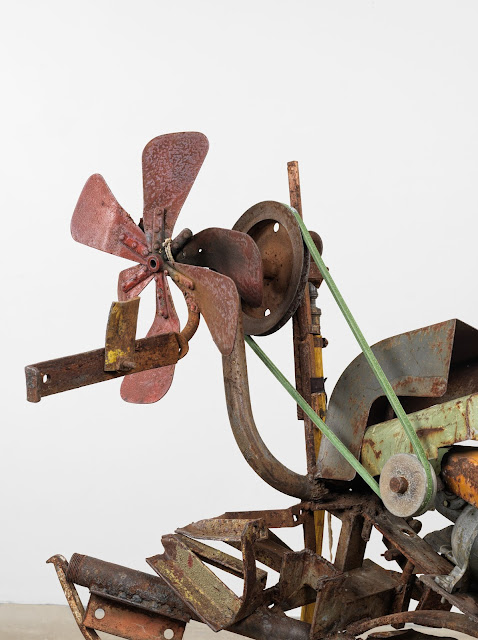

















































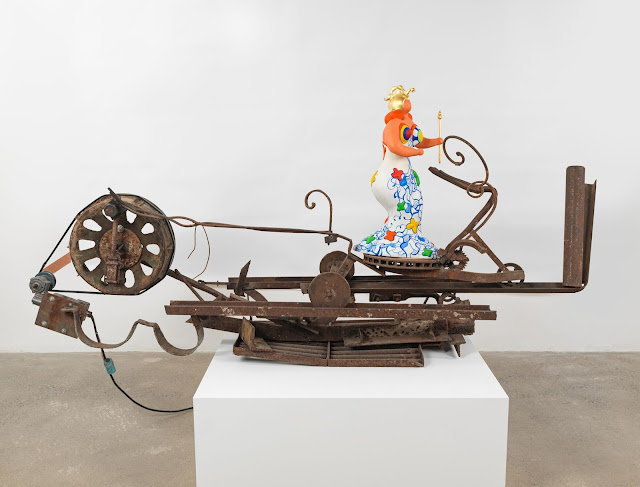








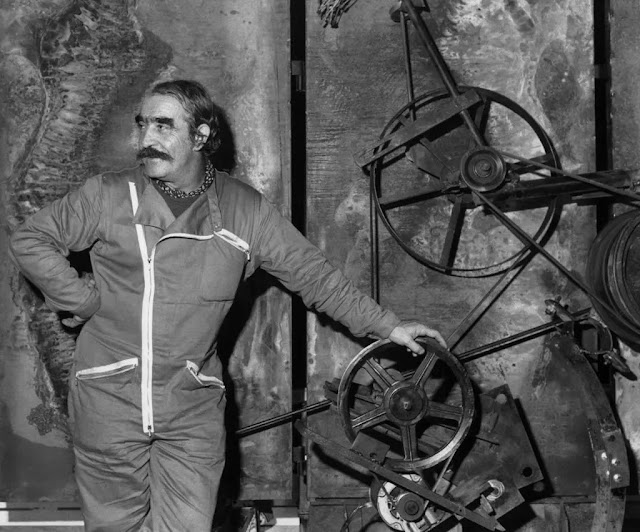






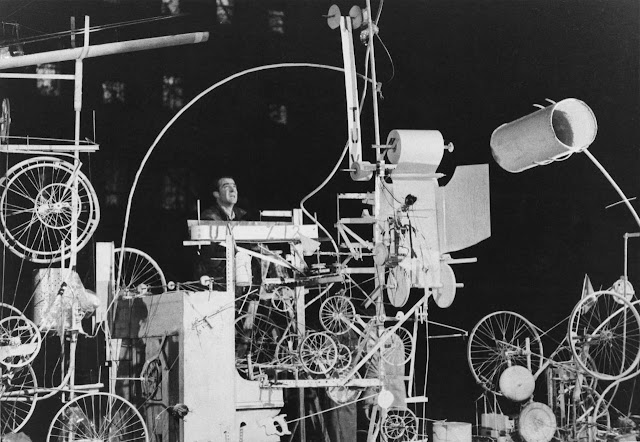

















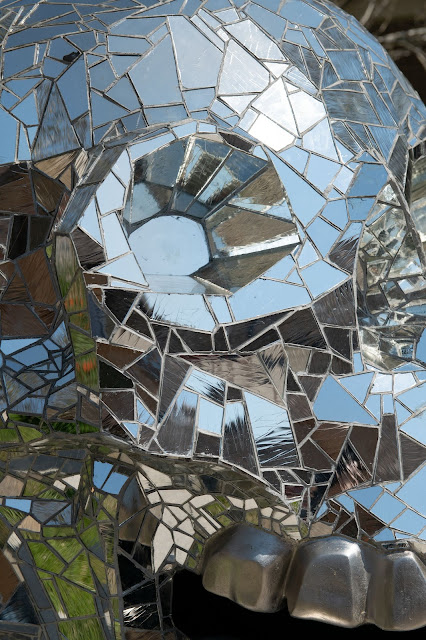




































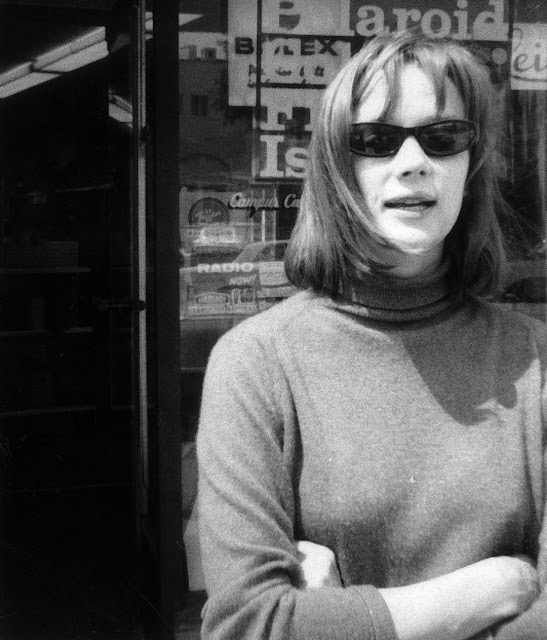
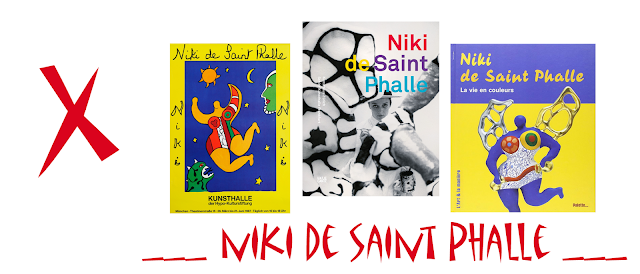





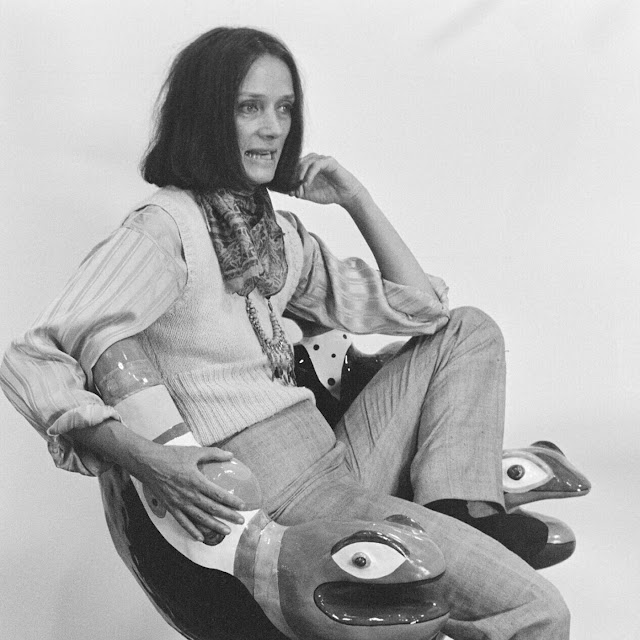










.png)